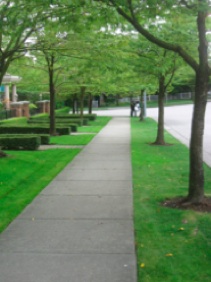Landscaping is often overlooked when streetscape accessibility is being discussed, but it is an important component of an inclusive environment. In addition to adding to the attractiveness of streetscapes, landscaping can offer shade and improve air quality. Landscaping, such as trees bordering a sidewalk, can provide directional cues to people with visual impairments, as well as act as a safety measure, creating a buffer between pedestrians and automobiles. Grassy areas are essential for people who rely on guide, service, and/or therapy dogs, as the dogs require areas to relieve themselves.
There are challenges when selecting the appropriate landscaping. The landscaper must ensure that the roots will not become a tripping hazard or affect the stability of the surface. They must consider the growth of the branches or bushes and ensure they don’t interfere with the path of travel. It is important for landscapers to avoid plants or trees with thorns as they can flatten the tires of mobility aids.
Landscaping has also been shown, in multiple studies, to be useful as a tool for people with certain medical issues; two examples are Attention Deficit Disorder and dementia. It has been shown that spending time each day near greenery benefits children with ADD. And, for some, symptoms of ADD can be reduced within green spaces. Likewise, green spaces have been shown to be of benefit for people with dementia. Studies have shown that exposure to environments with greenery can reduce negative and violent behaviour in patients with dementia in long term care facilities. Many long term care facilities are looking to landscaping to help reduce agitation, lessen fear, and increase positive feelings.
In addition to benefiting patients, landscaping has been proven to be of benefit to staff within medical settings; increasing patience, lessening frustration, and improving emotional and mental health. Spending time in green spaces can help to lower heart rates and blood pressure. Studies have shown that landscaping can help with burnout rates for staff as well as for caregivers. Having available landscaping and/or green spaces in medical settings offers a place to relieve stress in a very emotionally intense environment.
Having greenery, green spaces and/or landscaping near schools has been shown to help alleviate mental stress and fatigue. It has been shown to act as a positive distraction, benefitting mental, physical, and emotional health.
As more studies demonstrate the benefits of landscaping, facility designers are taking green spaces more seriously. They are recognizing that landscaping has a proven benefit to built environments, as well as to those who use the facilities.
Landscaping has an obvious aesthetic appeal, but less obvious is the effect it has on the accessibility of a space. Green spaces are part of creating inclusive communities. Greenery can be beneficial to the physical accessibility of a space as well as to how people respond emotionally and mentally to that space. Human well being is intimately connected with the environment that surrounds us. Ensuring we don’t lose sight of green spaces in urban settings is vital to our health, comfort, happiness and overall quality of life.

